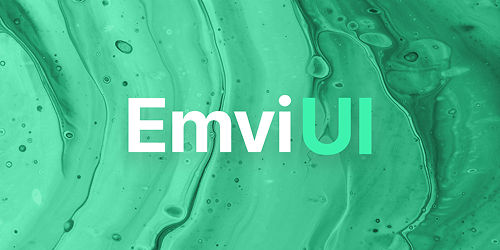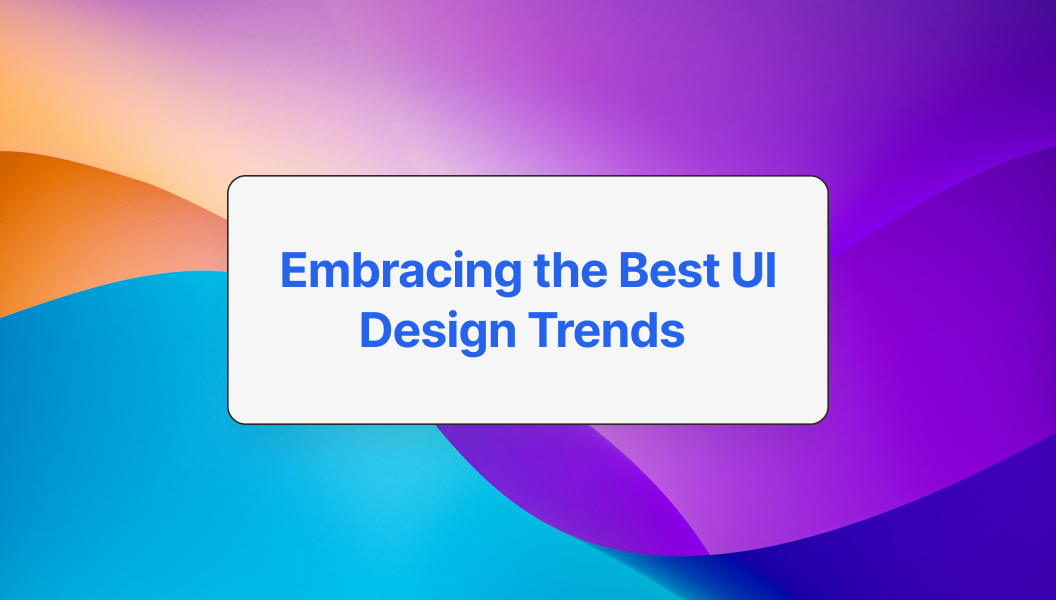Introduction to UI Design Trends
In the ever-evolving world of user interface (UI) design, staying up-to-date with the latest trends is crucial for creating engaging and innovative digital experiences. As we move into 2024, designers are eager to explore new approaches and techniques that enhance the usability and aesthetic appeal of their projects.
The Importance of Following Design Trends
UI design trends play a significant role in influencing how users interact with digital products. By keeping an eye on current trends, designers can create interfaces that not only look modern but also provide intuitive and seamless user experiences. Incorporating trending design elements can:
- Improve user engagement
- Enhance visual appeal
- Keep designs relevant and competitive
- Reflect current technological advancements
Incorporating the latest trends ensures that a design remains fresh and appealing to users, which can lead to higher satisfaction and better overall performance. For more details on maintaining relevancy in design, check out our article on ui design principles.
What to Expect in 2024
As we step into 2024, several UI design trends are expected to dominate the landscape. These trends are driven by technological advancements and evolving user preferences. Here are some key trends to watch out for:
| Trend | Description |
|---|---|
| Vibrant Color Palettes | Use of bold and dynamic colors to create eye-catching interfaces. |
| Dark Mode Designs | Increasing adoption of dark-themed interfaces for improved readability and user comfort. |
| Bold Typography | Use of striking fonts to grab attention and improve readability. |
| Handwritten and Custom Fonts | Incorporating unique, custom-made typefaces to add a personal touch. |
| Asymmetrical Layouts | Moving away from traditional grid layouts to create more dynamic compositions. |
| Non-Traditional Menus | Experimenting with navigation menus to enhance user interaction. |
| Microinteractions | Adding small, interactive elements to improve user engagement. |
| 3D and Immersive Designs | Leveraging 3D graphics and immersive elements for a richer experience. |
| Accessibility Features | Focusing on inclusivity and designing for all users, including those with disabilities. |
These trends reflect the industry's shift towards more engaging, visually appealing, and user-friendly designs. Adapting to these changes will help designers create interfaces that not only meet but exceed user expectations. To dive deeper into specific trends like dark mode designs and bold typography, explore our other articles such as best practices for ui design and figma ui design tutorial.
By understanding the significance of UI design trends and anticipating what's to come in 2024, designers can ensure that their projects remain cutting-edge and user-centric.
Color Trends in UI Design
Color is a crucial element in UI (User Interface) design, setting the tone and enhancing the overall user experience. In 2024, several color trends have emerged that UI designers should consider incorporating into their projects.
Vibrant Color Palettes
Vibrant color palettes are making a strong impact in UI design this year. Bold, bright colors can attract attention, evoke emotions, and create an engaging user experience. These lively palettes often involve the use of contrasting colors to create a dynamic and visually appealing interface.
To effectively implement vibrant color palettes, designers can use color theory to select complementary colors that work well together. This trend is perfect for apps and websites that aim to be fun, energetic, and engaging.
| Color Palette | Example Colors |
|---|---|
| Warm Vibrant | #FF5733, #FFC300, #FF5733 |
| Cool Vibrant | #33FF57, #33FFC3, #5733FF |
Dark Mode Designs
Dark mode design continues to be a popular trend in UI design. Dark mode provides a sleek and modern look, reduces eye strain in low-light conditions, and can also save battery life on OLED screens. Incorporating dark mode options in your design allows users to switch between light and dark themes based on their preferences.
When designing for dark mode, it's important to maintain readability and accessibility. Use high-contrast colors for text and important elements to ensure they stand out against the dark background.
| Dark Mode | Example Colors |
|---|---|
| Background | #121212 (Dark Gray) |
| Primary Text | #E4E4E4 (Light Gray) |
| Accent | #BB86FC (Purple) |
Implementing these color trends in your UI designs can enhance user engagement and create more visually appealing interfaces. For more insights on design trends, explore our article on best practices for ui design.
Typography Trends
Typography is a crucial aspect of UI design and plays a significant role in creating engaging and accessible interfaces. In 2024, several typography trends are set to dominate the design landscape.
Bold and Eye-Catching Fonts
Bold fonts have been rising in popularity and are set to continue in 2024. These fonts grab attention and make a statement, making them ideal for headings, titles, and important calls to action. Bold typestyles help create hierarchy and guide users through the interface, making it easier to navigate and understand the content.
Using bold fonts effectively involves balancing them with other elements in the design. For instance, a bold title paired with lighter body text can create a visually appealing contrast that enhances readability.
To incorporate bold and eye-catching fonts in your projects, it's important to follow best practices for UI design to ensure the overall look remains cohesive and user-friendly.
Handwritten and Custom Typography
Handwritten and custom typography brings a personal and unique touch to UI design. These fonts add a sense of authenticity and creativity, making the design stand out from more conventional typefaces. Handwritten fonts are often used in logos, social media graphics, and interfaces where a distinct personality is desired.
Custom typography allows designers to create bespoke fonts tailored specifically to the brand's identity. This ensures consistency and uniqueness across all digital touchpoints. Creating custom typography, however, requires a deep understanding of ui design principles to maintain legibility and accessibility.
To highlight the effectiveness of handwritten and custom typography, let's look at how they compare in terms of user engagement:
| Typography Style | Engagement Level |
|---|---|
| Standard Fonts | Moderate |
| Bold Fonts | High |
| Handwritten Fonts | Very High |
By exploring these typography trends, UI designers can create more engaging and visually compelling interfaces. Whether using bold fonts for strong statements or handwritten/custom fonts for a personal touch, understanding and applying these trends will enhance user experience. For more insights and tutorials on UI design, visit our Figma UI design tutorial.
Layout and Navigation Trends
In the fast-evolving field of UI design, layout and navigation have seen some compelling changes. As we move into 2024, two trends stand out: asymmetrical layouts and non-traditional navigation menus.
Asymmetrical Layouts
Asymmetrical layouts break free from the grid-based designs that have dominated UI for years. They bring a more dynamic and interesting look to interfaces. These layouts provide a refreshing departure from symmetry and uniformity, allowing designers to create more engaging and unpredictable visual experiences.
Key Benefits of Asymmetrical Layouts:
- Visual Interest: Adds excitement and movement.
- Hierarchy: Guides the user's eye to important elements.
- Flexibility: Allows for creative freedom.
Here's a comparison table highlighting the differences between symmetrical and asymmetrical layouts:
| Feature | Symmetrical Layouts | Asymmetrical Layouts |
|---|---|---|
| Structure | Balanced and even | Unpredictable and dynamic |
| Visual Flow | Predictable | Guided but varied |
| Creativity | Limited by symmetry | High flexibility |
For more insights on effective design practices, check out our article on best practices for ui design.
Non-Traditional Navigation Menus
Navigation menus are crucial for usability, and 2024 brings innovative changes. Non-traditional navigation menus, such as hidden menus, sidebar navigation, and floating action buttons, are gaining traction. These menus provide a seamless way to navigate without cluttering the screen.
Popular Non-Traditional Navigation Types:
- Hidden Menus: These appear when needed, keeping the UI clean. Examples include hamburger menus and drop-downs.
- Sidebar Navigation: Offers easy access without compromising screen space.
- Floating Action Buttons: Provides immediate access to key actions in an intuitive way.
| Navigation Type | Description | Visibility |
|---|---|---|
| Hidden Menus | Appear on interaction (e.g., hamburger menus) | Low until activated |
| Sidebar Navigation | Persistent or collapsible side menu | Medium to high |
| Floating Action Buttons | Contextual buttons for immediate action | High in context |
Explore the benefits and limitations of various navigation styles in our ui design principles article.
By embracing asymmetrical layouts and non-traditional navigation menus, UI designers can create unique and engaging user experiences that stand out in 2024. These trends allow for greater creativity and usability, making interfaces more appealing and user-friendly. For further learning, delve into our figma ui design tutorial to see how these trends can be implemented in your projects.
Interactive and Animation Trends
In 2024, interactive elements and animations will play a crucial role in elevating user experience. These design trends make applications more engaging and dynamic.
Microinteractions
Microinteractions are subtle animations or feedback that provide visual cues to users. They enhance usability by making interactions more intuitive. Examples of microinteractions include button presses, input field validations, and simple hover effects.
Microinteractions serve a range of functions:
- Feedback: Offering immediate responses to user actions, like a "like" button animating when clicked.
- Guidance: Suggesting how to complete a task, like showing a text input getting validated.
- Communication: Informing users about system status, like a loading spinner.
Incorporating microinteractions can significantly enhance the user experience. For more details on effective use of microinteractions, see our article on ui design principles.
3D and Immersive Designs
3D elements and immersive designs are set to be a big hit in 2024. Incorporating 3D graphics can make your design stand out and provide a more engaging experience.
Key aspects of 3D and immersive designs:
- Realism: High-quality, realistic 3D models.
- Interactivity: Allowing users to interact with 3D objects.
- Context: Creating immersive environments that support the content.
3D elements can include everything from simple 3D buttons and icons to more complex scenes and animations. Be mindful of performance considerations and ensure that 3D graphics do not compromise loading times or overall user experience.
For a practical guide on creating immersive UI designs, check out our figma ui design tutorial.
The use of microinteractions and 3D designs will be essential for creating compelling interfaces. By integrating these trends carefully, designers can significantly enhance the user experience. For more tips on effective UI design, refer to our best practices for ui design.
Accessibility and Inclusivity Trends
Embracing accessibility and inclusivity in UI design is a significant trend in 2024. It ensures that digital products are usable for everyone, regardless of their abilities.
Designing for All Users
Designing for all users means creating interfaces that are accessible and inclusive. This involves considering the needs of users with disabilities, such as visual impairments, hearing loss, or motor limitations. By prioritizing accessibility, designers can create a more inclusive experience that benefits everyone.
Some key practices to design for everyone include:
- Alt Text for Images: Providing descriptive text for images
- Keyboard Navigation: Ensuring all interactive elements are usable with a keyboard
- Color Contrast: Using sufficient contrast between text and background
- Readable Fonts: Choosing fonts that are easy to read for all users
For more on general design principles, refer to our guide on ui design principles.
Importance of Accessibility Features
Incorporating accessibility features into your design is not just a trend but a necessity. These features enhance the user experience for people with disabilities and ensure that digital products comply with legal standards.
| Accessibility Feature | Benefits |
|---|---|
| Screen Reader Compatibility | Assists visually impaired users |
| Subtitles and Transcripts | Helps users with hearing impairments |
| Adjustable Font Sizes | Enhances readability for all users |
| Focus Indicators | Improves navigation for keyboard-only users |
Making your design accessible requires continuous learning and adjustment. Explore our best practices for ui design to stay updated with the latest methodologies.
By embedding these practices, UI designers can make their digital products available and enjoyable for a broader audience. Tools like Figma offer numerous features that support this effort. For detailed methods, check out our figma ui design tutorial and ui design prototyping tools.


